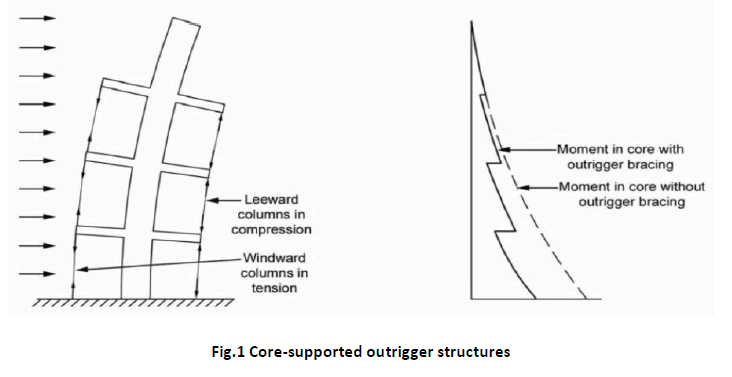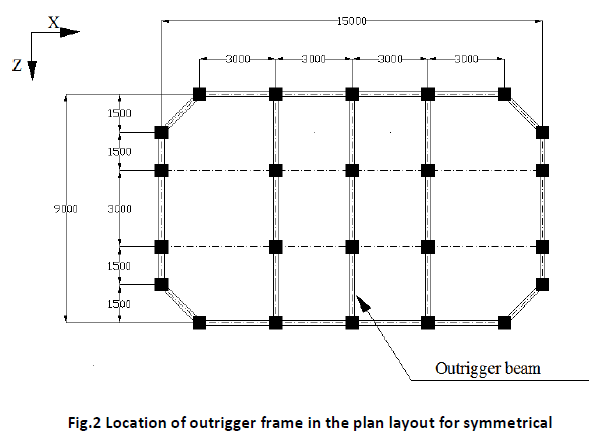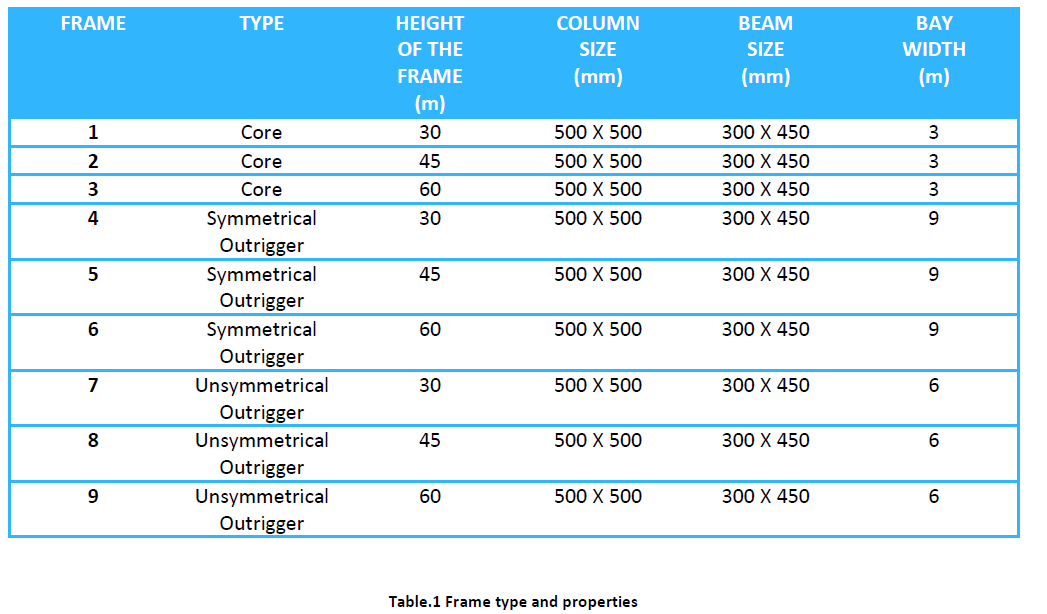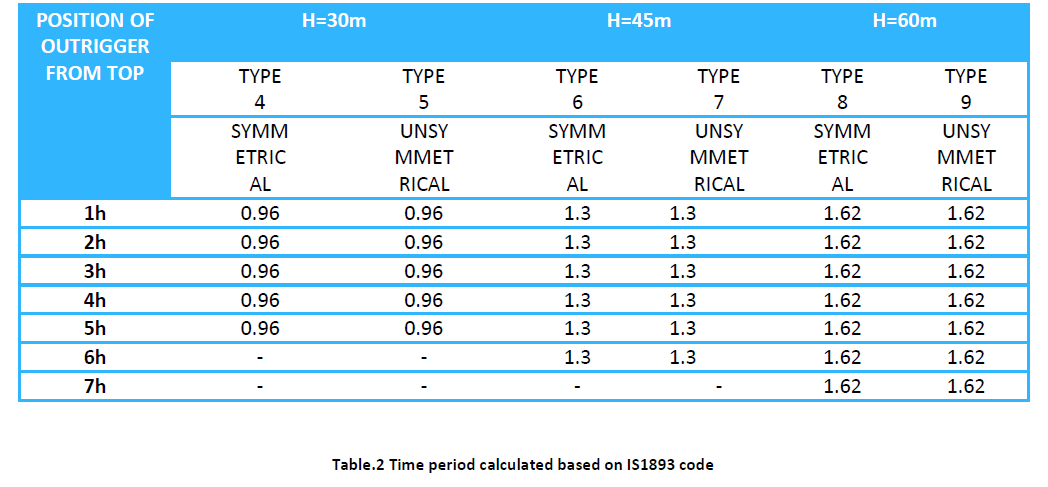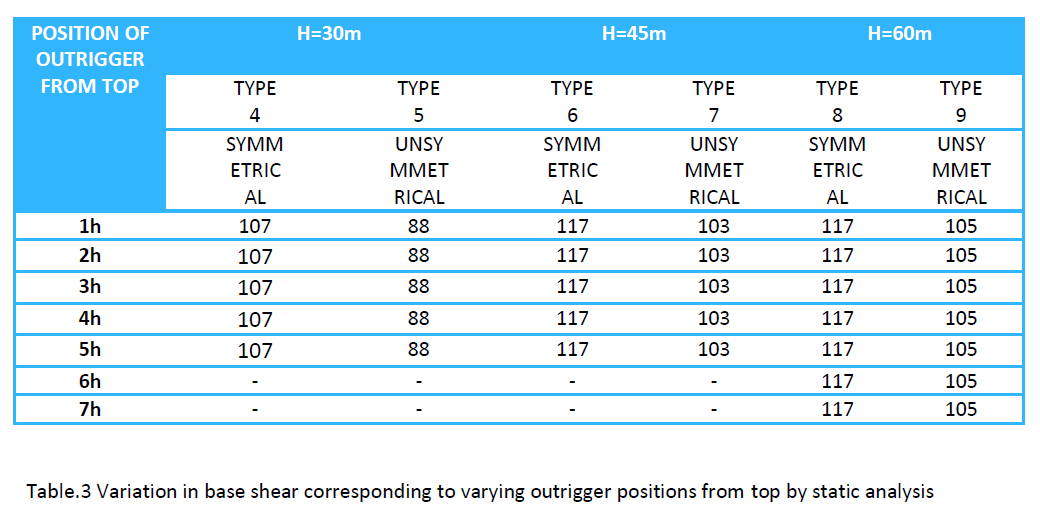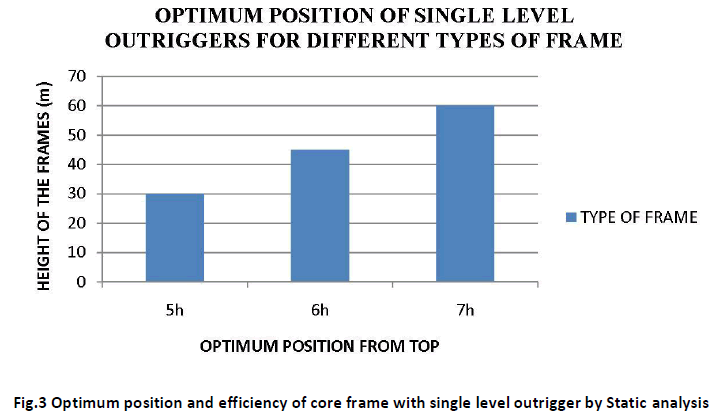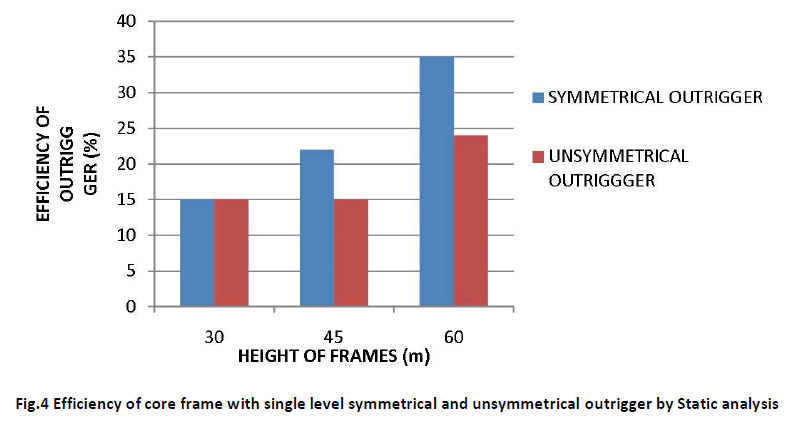Research Article Open Access
Feasibility Studies on the Use of Outrigger System for RC Core Frames
Dr.K.S.Sathyanarayanan, A.Vijay, S.BalachandarDepartment of Civil Engineering, SRM University, India
- *Corresponding Author:
- Dr.K.S.Sathyanarayanan
Department of Civil Engineering, SRM University, India
E-mail: srm.kssn@gmail.com
Visit for more related articles at International Journal of Advance Innovations, Thoughts & Ideas
Abstract
This research work is an attempt made to study the effect of provision of outriggers for single bay frame at single level and two levels for single bay of different heights 30m, 45m, and 60m. Finite element analysis has been done using standard structural software. The frame and outriggers are modeled by three degrees of freedom per node beam elements. Both symmetrical and unsymmetrical provisions of outriggers are included with the considered static loads. From the analysis the lateral displacements, internal forces, base shear values are obtained for each level of outrigger. The reduction in lateral displacement of core frame values is taken as the index of efficiency of outrigger system at a particular level. The optimum position of outrigger so as to give maximum efficiency is found out. Optimum position of single level symmetrical and unsymmetrical outrigger for 30m, 45m and 60m are at H/2, H/2.5 and H/2.85 from top. Where H is the storey height and height of the frame.
Keywords
Outrigger frames, symmetrical and unsymmetrical frames.
Introduction
For buildings taller than a certain height, moment resistant frames or braced core may not provide adequate stiffness to resist lateral load such as wind and earthquake loads. In this case the lateral stiffness can be increased by tying the exterior frames and the shear core together by outrigger trusses. The placement of outrigger trusses increases the effective depth of the structure and significantly improves its lateral stiffness under lateral load. The columns connected to outriggers resist the rotation and lateral deflection of the core and consequently axial forces are developed in the exterior columns due to lateral load as shown in Fig 1. Some advantages of the core-and-outrigger system are that the exterior column spacing can easily meet aesthetic and functional requirements, and the building’s perimeter framing system may consist of simple beam-column framing without the need for rigidframe-type connections. In addition, outrigger systems have a great height potential up to 150 stories and possibly more.
The outrigger systems may be formed in any combination of steel, concrete and composite construction because of the many functional benefits of outrigger systems and the advantages.
The area of behavior of outrigger systems has been under investigation by many researchers. To mention some of the recent works, Bayati et.al (2008) stated drift reduction in uniform belted structures with rigid outriggers, through the analysis of a sample structure were built in Tehran’s Vanak Park. Results show that using optimized multi-outriggers system can effectively reduce the seismic response of the building. In addition, the results show that a multi-outriggers system can decrease elements and foundation dimensions. Kwang Ryang Chung et.al (2008) have studied and proved the capacity of outrigger joint systems to resist differential column shortening during construction stages. The investigations of Kim et.al (2010) have proved that the progressive collapse resisting capacity of the structure with mega-columns and core walls connected by outrigger trusses could be enhanced by providing additional redundancy to the key elements such as megacolumns. It was observed that redesigning the structure with additional belt trusses or with moment connected interior/exterior frames significantly enhanced robustness of the structure. The review of literature on outrigger system indicates that studies on the adoption of sub systems for medium rise multi-storey RC frames are meager. Hence it is felt necessary to study the feasibility of use of such systems.
Research Significance
As it exists the present day shear wall system structures are used for medium high rise buildings and Outrigger braced structure has been effectively used for buildings from 40 to 70 stories high buildings. Hence study on effect of outrigger system for medium high rise buildings is felt significance.
Objective of The Study
(i) To study the static characteristics of multistoried RCC frames with single bay and with the inclusion of single and two levels outriggers and (ii) to arrive at the optimum outrigger position for 10, 15 and 20 storied buildings.
Scope of The Study
Analytical study on multistory reinforced concrete frame, with single and two levels of outriggers for seismic loading for 10, 15 and 20 storied buildings using standard structural software. Parameters kept constant in analytical study are flexural rigidity of the outrigger members, axial rigidity of external columns, number of levels of the outrigger and foundation condition is fixed. Parameters varied in analytical study are height of the frame and location of outrigger.
Methodology
1. Dead load and live load calculation for the chosen layout are carried out.
2. 2D analysis is done because the structural system behaves like vertical cantilever when it is subjected to in- plane bending.
3. The equivalent study load is evaluated as per IS 1893 (2002) for Zone 5.
4. Analysis by provision of outrigger at different levels and finding displacements and other results.
5. Calculation of efficiency of outrigger is carried out based on maximum lateral displacement.
6. Lateral displacement of core and with outrigger system at any instance = (difference between lateral displacement of core and core with outrigger / displacement of core alone) X 100
Details of Analytical Investigation
The analytical study of dynamic behaviour on multi storied reinforced single bay frame with two level outrigger structural systems.
Details of Frame Analysed
Layout
The plan layout considered are shown in Fig 2 wherein the locations of outrigger frame are indicated for symmetrical and unsymmetrical cases respectively.
The seismic parameters considered are exhibited to Zone Factor (Z) 5 which is 0.36; hard soil type for which the Damping value provided is 5%. The importance factor (I) is considered as 1.5 and Response reduction factor (R) is 5.
The general properties of the frame includes the grade of concrete M20, the young’s modulus of the concrete is 22360679.78 kN/m2 (as per IS 456-2000, 500 20).
The general properties in respect to all the frames are given below:
• Grade of concrete : M20
• Young’s modulus of concrete : 22360679.78 kN/m2 (As per IS 456-2000,5000√20)
• Width of shear wall : 3m
• Bay width of the frame : 3m
• Floor height : 3m
The loads given to all the frames are given below
• Floor finish : 2kN/m2
• Live load : 4 kN/m2
• Live load in core area : 5 kN/m2
• Light partition and ducting : 2 kN/m2
The type of frames used and their geometrical properties are listed in the table 1.
Analysis Details
Time period calculated as per IS1893-1 (2002) clause 7.6.1 present in Table 2,
T=0.075 x H 0.75 (1) Where, T - Time period in sec H - Total height of building in m
Base shear calculated as per IS1893:Part-I (2002) clause 7.5.3
VB = W x Ah (2) Where,
VB - Base shear.
W - Seismic weight of the building.
Ah - Design horizontal acceleration spectrum.
Ah = Z/2 x I/R x (Sa/g) (3)
Where,
Z - Zone factor.
I - Importance factor.
R - Response reduction factor.
Sa/g - Spectral acceleration+
The base shear calculated are presented in Table 3
Optimum position and efficiency of core frame single level outrigger
Optimum position and efficiency of core frame with single level outrigger by static analysis are shown in figure 3.
Core Frame Results
The results for core frame alone based on static analysis and dynamic analysis are presented in Table 4. Static analysis based on IS1893: Part-I(2002) code.
Efficiency Based On Drift
This study was done to restrict the drift of core within allowable limits. The efficiency is defined as the difference between the core drift to the core drift with outrigger to that core drift. From the efficiency the optimum position of outrigger is arrived. For arriving the efficiency the graphs are drawn peak in the graph corresponds to the maximum efficiency of the outrigger.
For two levels outrigger with one outrigger is fixed at top, and the other outrigger is fixed at optimum level arrived from single outrigger analysis.
Time Period
First mode time period is considered since of fundamental mode for static analysis and presented in Tables 7 and 8.
Base Shear
The base shear results of symmetrical and unsymmetrical outrigger braced systems are presented in Tables 9 and 10.
Conclusion
Effect of Symmetrical & unsymmetrical single and two level outrigger structural systems for the different heights of frame 30m, 45m and 60m are studied for drift, time period and base shear. From the results obtained, Optimum position of single level symmetrical and unsymmetrical outrigger for 30m, 45m &60m are 5h, 6h &7h means H/2, H/2.5 & H/2.85. Where h & H are storey height and height of the frame.
a) Symmetrical single level outrigger
• Efficiency of outriggers for 30m, 45m and 60m are 5h, 6h and7h are 15%, 22% and 35%.
• Time period and base shear for 30m, 45m and 60m are 1.23 sec,2.4sec and3.2 sec and 93.5kN, 87.3kN and 85.6kN respectively
b) Unsymmetrical single level outrigger
• Efficiency of outriggers for 30m, 45m and 60m are 5h, 6h and7h are 15%, 15% and 24%
• Time period and base shear for 30m, 45m and 60m are 1.21 sec,2.1sec and3.26 sec and 83kN, 83kN and 82kN respectively
c) Symmetrical two level outrigger
• Efficiency of outriggers for 30m, 45m and 60m at 1h and 5h, 1h and 6h, 1h and 7h are 6.39%, 16.94% and 31.38%.
• Time period and base shear for 30m,45m and 60m at 1h and 5h, 1h and 6h, 1h and 7h are 1.46 sec, 2.54sec and3.71 sec and 113kN, 95kN and 91kN respectively
d) Unsymmetrical two level outrigger
• Efficiency of outriggers for 30m, 45m and 60m are 5h, 6h and 7h are 4.36%, 14.82% and 25%.
• Time period and base shear for 30m,45m and 60m at 1h and 5h, 1h and 6h, 1h and 7h are 1.42 sec, 2.36sec and3.54 sec and 89kN, 85kN and 85kN respectively
References
- Bayati,Z Mahdikhani m. and Rahaei a. (2008) ‘Optimized use of multi-outriggers system to stiffen tall buildings’, The 14th world Conference on Earthquake Engineering, Beijing, China dated October 12-17, 2008.
- Gerasimidis s, Efthymiou e. and Baniotopoulos c. c. , et.al (2009) ‘Optimum outrigger locations of high-rise steel buildings for wind loading’ ,Institute of Metal Structures, Department of Civil Engineering, Aristotle University of Thessaloniki, GR-54124, Thessaloniki, Greece.
- Hoenderkamp JCD. (2004) ‘Shear Wall with Outrigger Trusses on Wall and Column Foundations’. The Structural Design of Tall and Special Buildings. Issue 13: 73–87
- Hoenderkamp JCD, Snijder HH. (2000). ‘Simplified analysis of façade rigger braced high-rise structures’. Structural Design of Tall Buildings. Issue 9: 309–319.
- Hoenderkamp JCD, Snijder HH.(2003). ‘Preliminary analysis of high-rise braced frames with façade riggers’ .Journal of Structural Engineering, ASCE 129(5): 640– 647.
- IS: 1893 part-1 (2002), “criteria for earthquake resistant design of structures”. [7]. Kwang Ryang Chung, David Scott, Do Hyun Kim, et.al (2008) ‘Structural System of North-East Asia Trade Tower in Korea’, CTBUH 8th World Congress.
Relevant Topics
- Advance Techniques in cancer treatments
- Advanced Techniques in Rehabilitation
- Artificial Intelligence
- Blockchain Technology
- Diabetes care
- Digital Transformation
- Innovations & Tends in Pharma
- Innovations in Diagnosis & Treatment
- Innovations in Immunology
- Innovations in Neuroscience
- Innovations in ophthalmology
- Life Science and Brain research
- Machine Learning
- New inventions & Patents
- Quantum Computing
Recommended Journals
Article Tools
Article Usage
- Total views: 16364
- [From(publication date):
May-2012 - Jul 08, 2025] - Breakdown by view type
- HTML page views : 11542
- PDF downloads : 4822

